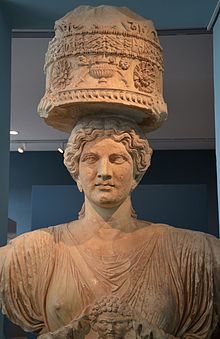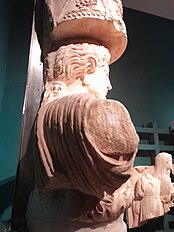Caryatids of Eleusis
| Caryatids of Eleusis | |
|---|---|
| Καρυάτιδες της Ελευσίνας | |
 Saint Demetra in the Fitzwilliam Museum | |
 Caryatid B in the Archaeological Museum of Eleusis | |
| Type | Sculpture |
| Material | Marble |
| Height | 2.09 m (Saint Demetra) 1.96 m. (Caryatid B) |
| Width | 1.50 m (Caryatid B) |
| Created | 1st century BC |
| Discovered | 1892 (Caryatid B) Eleusis |
| Present location | Fitzwilliam Museum, Cambridge (Saint Demetra) Archaeological Museum of Eleusis, Eleusis (Caryatid B) |
| Culture | Greco-Roman |
In antiquity, two large Caryatids from the Lesser Propylaea adorned the sanctuary of the Greek goddess of agriculture Demeter at Eleusis in Greece as architectural support taking the place of columns. Following the Christianization of the Roman Empire, one of the Caryatids was dubbed Saint Demetra by the locals and worshipped as patron saint of agriculture and crops. The Caryatid was removed from Eleusis in 1801 by Englishman Edward Daniel Clarke, who later donated it to the University of Cambridge; it remains on display in the Fitzwilliam Museum.
The second Caryatid B, preserved in a better condition than Saint Demetra, was unearthed in Eleusis some ninety years after the other one was taken, and it is exhibited in the Archaeological Museum of Eleusis.
Greece is seeking the repatriation of the other Caryatid.
Dating and Christian worship[edit]
It has been suggested that the pair were idealised portraits of the daughters of Appius Claudius Pulcher, the Roman consul who dedicated the gateway that they supported, between 54 and 48 BC.[1]
Although Emperor Theodosius I issued the Edict of Thessalonica, banning paganism throughout the Roman Empire, people in Greece continued to worship Demeter, now dubbed "Saint Demetra", as patron saint of agriculture.[2] The people of Eleusis worshipped the caryatid as an icon of Saint Demetra, and would cover it with flowers and garlands,[3] as they believed that the goddess was able to bring fertility to their fields and bless their crops.[4] The stories surrounding Saint Demetra had many similarities with the myth of Demeter's daughter Persephone's abduction by Hades, only in the Christian context the girl had been abducted by a Turk.[5] The worship of the statue as the uncanonised Saint Demetra (Greek: Αγία Δήμητρα) was against the traditions of the iconoclastic Church.[3] Those traditions continued even after the fall of the Eastern Roman Empire, well into the Ottoman era.
The statue was noted in 1676 by the traveller George Wheler, and several ambassadors who had submitted applications to the Ottomans for its removal with any success.[6][7] Around 1765–1766, the antiquary Richard Chandler, along with the architect Nicholas Revett and the painter William Pars, visited Eleusis and mentioned the statue as well as the local folklore about it.[5]
Removal[edit]
In 1801, English clergyman Edward Daniel Clarke and his assistant John Marten Cripps managed to obtain an authorisation through bribery from the governor of Athens for the removal of Saint Demetra, with the help of Giovanni Battista Lusieri, an Italian artist who was Lord Elgin's assistant at the time.[8]
Clarke was the one to remove the statue by force,[3] after bribing the local waiwode of Athens and obtaining an edict,[6][4] despite the objections of the local population,[3][9] who feared that removal of Saint Demetra would cause their crops to fail.[6][3][10][11] Nevertheless, Clarke was successful, though not without struggle. An ox broke free of its halter the day before the removal and dashed against Saint Demetra with its horns, alarming the locals who took it to be a bad omen for the crops.[5] Clarke assured them that they would suffer no harm, and brought a Christian priest from Aegina who first broke the soil around the statue to prove nothing would happen.[12] Furthermore, on April 23, 1802, the ship carrying the statue sank off the southeastern coast of England, though the Saint Demetra was recovered the following year.[12] As for the Eleusinians, they had a good harvest the following year, which confirmed their beliefs that the caryatid would some day be returned to them; but then came a run of bad years in succession, which they blamed on them having allowed Saint Demetra to be taken away.[12]
He donated Saint Demetra along with other findings to the University of Cambridge in 1803; the statue of Demeter would be displayed at the University Library. In 1865 the collection was transferred to the Fitzwilliam Museum in Cambridge, where it became one of the museum's two main collections.[6]
In 2022, the municipality of Eleusis asked the museum to return Saint Demetra to Greece.[13]
Description[edit]
The Caryatids are very similar, though not identical, even after the extensive damage Saint Demetra bears, compared to the Eleusis Caryatid, is taken into account. Both only have their colossal torsos, heads and headgears survive to this day, though it is more likely than not that both originally represented a full-length figure, with their arms raised above their head to hold the cylindrical object that balances upon it, the 'cista'. The cista was a type of container often used to store cosmetics. The cistas held by the caryatids probably contained sacred objects associated with the rites conducted at Eleusis, though such knowledge does not exist.[1]
The vessel on both caryatids are decorated with emblems and items associated with the rituals of the Eleusinian Mysteries, such as ears of corn, rosettes, cakes, and bundles of myrtle. A plemochoe is carved directly above the brow of each female figure, that is, a container where the kykeon was most likely held. The kykeon was the sacred drink used during initiation into Demeter and Persephone's cult.[1]
The two priestesses wear two tunics each, which are secured on their breast with diagonally crossing straps; their chest is further decorated with a gorgoneion brooch. Saint Demetra's face, which is no longer preserved, was inclined to the left, as though she was looking down onto those passing in procession through the gateway beneath her. The face of the Caryatid B is much better preserved.[1] The better-preserved Caryatid measures 196 cm in height and 150 cm in width.[14] They weigh around two tonnes each.[8]
Gallery[edit]
- Caryatids of Eleusis
- Torlonia Caryatid in the Eleusis type
- Face of Caryatid B
- Engraving by P. W. Tomkins
- Posterior view.
See also[edit]
- Elgin Marbles, collection of sculptures taken from the Parthenon.
- Las Incantadas, four columns with reliefs taken from Salonica.
- Aegina Treasure, Minoan gold hoard taken from Aegina.
References[edit]
- ^ a b c d "Caryatid". fitzmuseum.cam.ac.uk. University of Cambridge. Retrieved January 8, 2024.
- ^ Keller, Mara Lynn (1988). "The Eleusinian Mysteries of Demeter and Persephone: Fertility, Sexuality, and Rebirth". Journal of Feminist Studies in Religion. 4 (1): 27–54. ISSN 8755-4178. JSTOR 25002068.
- ^ a b c d e Lawson 2012, pp 79–80: Further, in open defiance of an iconoclastic Church, they retained an old statue of Demeter, and merely prefixing the title 'saint ' to the ... Then, in 1801, two Englishmen, named Clarke and Cripps, armed by the Turkish authorities with a license to plunder, perpetrated an act ... and in spite of a riot among the peasants of Eleusis removed by force the venerable marble; and that which was the visible form of ...
- ^ a b Sharma 2005, p. 47.
- ^ a b c Cosmopoulos 2015, p. 35.
- ^ a b c d Wroth, Warwick William (1887). . In Stephen, Leslie (ed.). Dictionary of National Biography. Vol. 10. London: Smith, Elder & Co. p. 422.
His chief prize was obtained at Eleusis, whence he succeeded in carrying off the colossal Greek statue (of the fourth or third ...) supposed by Clarke to be 'Ceres' (Demeter) herself, but now generally called a 'Kistophoros'... statue and with Clarke's other Greek marbles, was wrecked near Beachy Head, not far from the home of Mr. Cripps, whose ...
- ^ Spivey 2013, p. 92.
- ^ a b Fagan 2006, p. 54.
- ^ Patrick Leigh Fermor (1984). Mani: Travels in the Southern Peloponnese. Penguin Books. p. 180. ISBN 978-0-14-011511-6.
uncanonical 'St. Demetra', was Eleusis, the former home of her most sacred rites in the Eleusinian mysteries. ... for prosperous harvests until two Englishmen called Clark and Cripps, armed with a document from the local pasha, carried her off from the heart of the outraged and rioting peasantry, in 1801. ...
- ^ "Edward Daniel Clarke (1769–1822)". The Fitzwilliam Museum. Archived from the original on 2 March 2014.
- ^ Adolf Theodor F. Michaelis (1882). Ancient marbles in Great Britain, tr. by C.A.M. Fennell. p. 244.
Clarke who in company with J. M. Cripps (also of Jesus College, Cambridge), was lucky enough (AD 1801) to get possession of this colossus in spite of the objections of the people of Eleusis, and to ship it with great trouble.
- ^ a b c Cosmopoulos 2015, p. 36.
- ^ "Αίτημα επαναπατρισμού της Ελευσινιακής καρυάτιδας στέλνει ο δήμος Ελευσίνας". www.elefsina.gr (in Greek). July 29, 2022. Retrieved January 5, 2024.
- ^ "Καρυάτιδα Κιστοφόρος, Αρχαιολογικό μουσείο Ελευσίνας, Αττική" [Kistophoros Caryatid, Archaeological Museum of Eleusis, Attica]. 2steps.gr (in Greek). Retrieved January 8, 2024.
Bibliography[edit]
- Cosmopoulos, Michael B. (2015). Bronze Age Eleusis and the Origins of the Eleusinian Mysteries. Cambridge University Press. ISBN 978-1-316-36823-7.
- Fagan, Brian (2006). From Stonehenge to Samarkand: An Anthology of Archaeological Travel Writing. Oxford University Press. ISBN 978-0-19-516091-8.
- Lawson, John Cuthbert (2012). Modern Greek Folklore and Ancient Greek Religion: A Study in Survivals. Cambridge University Press. pp. 79–80. ISBN 978-1-107-67703-6.
- Sharma, Arvind (2005). Goddesses And Women In The Indic Religious Tradition. BRILL. ISBN 978-90-04-12466-0.
- Spivey, Nigel (2013). Greek Sculpture. Cambridge University Press. ISBN 978-1-107-06704-2.
External links[edit]
 Media related to Saint Demetra of Eleusis at Wikimedia Commons
Media related to Saint Demetra of Eleusis at Wikimedia Commons Media related to Caryatid from Lesser Propylaia at Wikimedia Commons
Media related to Caryatid from Lesser Propylaia at Wikimedia Commons


 French
French Deutsch
Deutsch


